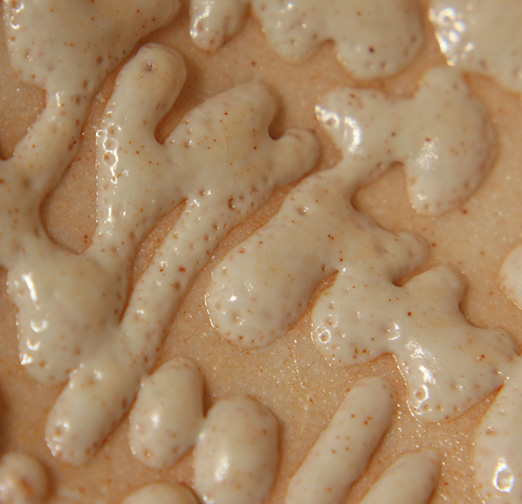High Alumina Orange
firing to cone 10 in oxidation
slow downfire at 50 deg F an hour in the interval 1850 deg F to 1700 deg F
slow downfire at 25 deg F an hour in the interval 1700 deg F to 1650 deg F
One hour hold at 1650 deg F
In my pursuit of the magic pumpkin orange color, I am investigating glazes with ever higher alumina (in its Emperical Formula).
These glazes have higher alumina than prior glazes in this series, and show a shift in color from brownish to pinkish orange.
Alumina is greater than 1.3 and the silica:alumina ratio is between 3 and 3.5, with Iron concentration is ~.03.
These high alkaline glazes, having a total CaO plus MgO ~.06 resulting from impurities in the feldspars and clays.
The names of these glazes reflect only that shino glazes are nearly unique in having such high alumina, making these glazes remote cousins of shino's.
To the right of a picture of a pot with this glaze, is a close up of a magnification of a small section of the glazed pot.
The pots are small conical bowls ~3 inches in diameter.
glaze shino_2016_03_31_0
Of the three glazes, this first glaze, shino_2016_03_31_0 has the lowest alumina, alumina equal 1.3 and the highest silica:Alumina ratio of 3.5.
The color of this glaze is yellower than the others.
 |
 |
glaze shino_2016_03_31_1
this second glaze, shino_2016_03_31_1 has alumina equal 1.5 and the next highest silica:Alumina ratio of 3.1.
The color of this glaze is pinkish. Note the hint of iridescence in the close up. It crawls, yet not as dramatically as the next glaze.
 |
 |
glaze shino_2016_03_31_2
this third glaze, shino_2016_03_31_2 has alumina equal 1.5 and the lowest silica:Alumina ratio of 3.
The color of this glaze is pinkish. Note the hint of iridescence in the close up. The strong crawl pattern is likely the result of its high clay content, the highest of the three glazes.
This glaze has the highest Lithia content of all three glazes, indicating that lithia may not strongly influence color.
 |
 |